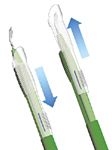Article
New Product Focus: Blades add safety, performance
A recently introduced line of reusable safety blades can help to minimize the risk of sharps injuries in the operating room.

Since receiving a supply of the 3-mm keratomes, Randal J. Rabon, MD, a private practitioner from Johnson City, TN, has been using that instrument to create both his paracentesis and main corneal incisions.
"Extension, retraction, and locking of the safety guard are all done one-handed, and the manipulations seem easier than with some other safety blades I've tried before," Dr. Rabon said. "The keratome has excellent ergonomics, its handle has a ridged, non-slip grip, the blade design allows me to use the knife as a dual-purpose instrument, and the matte-like finish of the blade does not reflect light and produce glare. Most importantly, however, the blade is very sharp and performs reliably in making precise cuts."

"However, with the 3-mm keratome, I was immediately comfortable during my first case," Dr. Rabon added.
Reducing possibility of infection
The safety guard completely covers the blade to protect against sharps injuries when the instrument is not in use. It is constructed of a clear material that retracts to provide an unimpeded view of the surgical field, and it is moved and locked into place by pressing with the thumb on a raised pad on the guard.
"As most surgeons know, the risk of transmission of bloodborne pathogens and prion-mediated disease has heightened both our awareness and the awareness of government oversight agencies of the need to eliminate sharps injuries in the operating room," Dr. Rabon said. "In addition to reducing the possibility of an actual infection, compliance with regulations and the desire to reduce employee anxiety as well as the cost of serologic testing should be enough to motivate us all to move toward this technology."
The design of the keratome, with respect to the angle of the blade, is similar to the instrument Dr. Rabon was using before. He said he did not need to alter his wrist position at all when he began operating with the new blade.
He added that he likes the ability to use the 3-mm keratome to create both the stab and main corneal incisions. Eliminating both the need for a second instrument and the time spent handing off for a second blade provide a cost benefit.
"With the narrow cost margins today, any potential savings are important, and especially for surgeons who work in their own surgery center," Dr. Rabon said. "The money saved per case both in direct costs and improved operating room efficiency by using one blade for incisions instead of two can add up significantly over a year's time."

FYI
Randal J. Rabon, MD
E-mail: rjrabon@comcast.net
Dr. Rabon has no financial interest in the subject matter.
Newsletter
Don’t miss out—get Ophthalmology Times updates on the latest clinical advancements and expert interviews, straight to your inbox.





